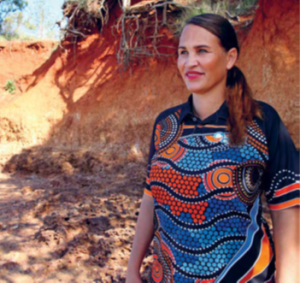Please note: Tammy has named people who have shared their wisdom and kindness in life with her and who are now deceased. Through telling her story she wishes to honour them because of the profound impact they have had on the work Tammy has done. She acknowledges the wisdom and guidance of her Aboriginal and Torres Strait Islander friends and colleagues who have walked alongside her in our collective cultural humility storyline.
Changemaker Spotlight – Tammy Wallace : A Grounded Presence in Leadership
“Culture is your strength”

Tammy Wallace is a proud Jirrbal woman from Far North Queensland. Her grandmother, Maisie (Yarrcali) Barlow, gifted her the traditional name Mahjah, meaning Lore Giver. Tammy holds this name with deep pride. It reflects her role in honouring the wisdom of her ancestors while shaping the future for First Nations children and families.
She brings culture, heart, and lived experience into every space she enters. Her work is shaped by a long-standing commitment to cultural humility and trauma-informed care. Tammy is a mother, a partner, an occupational therapist, and a strong advocate for healing that respects culture.
A Life of Purpose
Tammy has spent decades working in child protection, therapeutic care, and early childhood development. She has led Aboriginal practice and policy within government, worked in clinical services, and spent over ten years at MacKillop Institute supporting the Sanctuary Model. This trauma-informed framework was originally developed by Dr. Sandra Bloom and focuses on self-care, collaboration, and healing.
Tammy played a key role in adapting the model for Australian First Nations communities. Her guiding principle has been simple: “Our Culture is Our Sanctuary.” This belief gave rise to the Cultural Humility Commitment, now shaping national trauma-informed practice.
She credits the Aboriginal and Torres Strait Islander Working Group, formed to embed culture into the Sanctuary Model, and acknowledges leaders like Gerard Jones who helped bring the right people together.
What is Cultural Humility?
Tammy says cultural humility is not a buzzword. It is a way of being. It means walking beside, not ahead of, First Nations people. It means sharing power, listening deeply, and valuing culture as a strength, not an add-on.
Cultural humility involves:
- Awareness and understanding your own biases
- Decolonisation, acknowledging power imbalances and working in such a way that fixes them
- Working in partnership
- Honouring First Nations voices and affirming there is strength in culture
- Supporting healing without causing harm
- Being open, humble, and accountable
It is a lifelong commitment. It asks us to rethink systems built on colonial foundations and to create services that are culturally safe and inclusive.
The Power of Healing Through Culture
To help the interviewer’s understanding of how cultural humility and how sharing of power can prove beneficial for first nations people, Tammy provides an example of working with a young person who has suicidal ideation. She explains that clinical responses, like safety plans, hospital care, and medication, can help in the moment, but they are not enough on their own.
“We must acknowledge that the young person has experienced significant trauma, and it is that trauma which is behind the ideation” says Tammy “We need to support them to have a deeper understanding of their own experience and to process that trauma through their culture”.
True healing comes from creating a space to process trauma in a way that feels safe and familiar. For First Nations children and young people, this includes recognising intergenerational trauma and the impact of disconnection from culture.
“Trauma that is not transformed,” Tammy says, “is often transmitted.”
Cultural humility allows us to go deeper. It asks us to understand the reasons behind a young person’s pain and to support their healing through culture, connection, and trust.
Sharing Wisdom
It’s through this deep respect for cultural identity and healing that Tammy also shapes her guidance to the next generation of leaders.
To emerging First Nations leaders, Tammy offers this advice:
“Create space to affirm culture—in yourself and in your workplace. Understand power. Share knowledge. Know that our strength is in our culture.”
To young people, she says:
“Embrace your culture. It will guide you and protect you. It will never leave you. Your culture is your strength.”
A Legacy of Cultural Humility
Tammy Wallace doesn’t seek praise. She calls for action. She invites us all to reflect, learn, and change. Healing is not just found in systems—it is found in people who walk with humility, listen with care, and honour the stories of those they support.
Cultural humility is not just good practice. It is the foundation for lasting, respectful relationships and a better future for all children.
